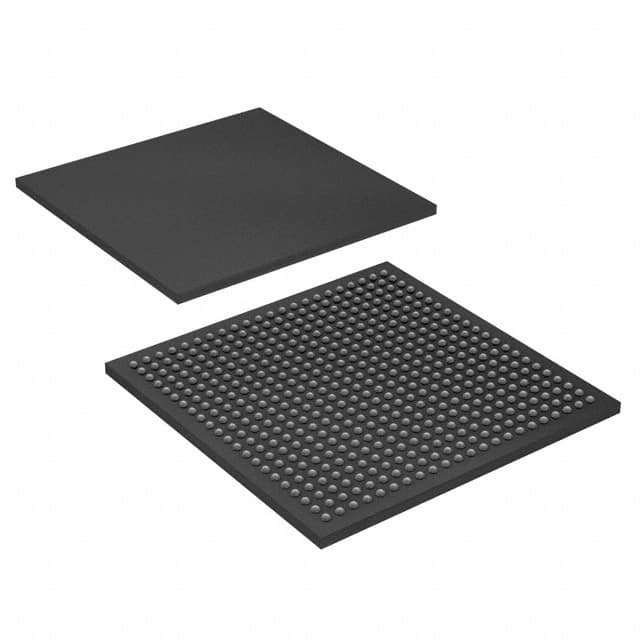Lihat spesifikasi untuk detail produk.

EP3SE50F484I4
Product Overview
- Category: Field Programmable Gate Array (FPGA)
- Use: EP3SE50F484I4 is a high-performance FPGA designed for various applications in the field of digital logic design and embedded systems.
- Characteristics:
- High-speed processing capabilities
- Configurable logic blocks
- On-chip memory
- Flexible I/O options
- Low power consumption
- Package: The EP3SE50F484I4 comes in a 484-pin FineLine BGA package.
- Essence: EP3SE50F484I4 is a versatile FPGA that offers programmable logic and on-chip resources to implement complex digital designs.
Specifications
- Logic Elements: 49,152
- Memory Blocks: 1,536
- Embedded Multipliers: 288
- Maximum User I/Os: 317
- Operating Voltage: 1.2V
- Operating Temperature Range: -40°C to 100°C
- Speed Grade: I4
Detailed Pin Configuration
The EP3SE50F484I4 has a total of 484 pins, each serving a specific purpose in the FPGA's functionality. For a detailed pin configuration diagram, please refer to the manufacturer's datasheet.
Functional Features
- High-speed processing: The FPGA offers fast data processing capabilities, making it suitable for applications requiring real-time performance.
- Configurable logic blocks: EP3SE50F484I4 provides a large number of configurable logic blocks, allowing users to implement custom logic functions.
- On-chip memory: The FPGA includes embedded memory blocks, enabling efficient storage and retrieval of data within the device.
- Flexible I/O options: EP3SE50F484I4 supports a wide range of input/output standards, facilitating seamless integration with external devices.
- Low power consumption: The FPGA is designed to operate efficiently, minimizing power consumption and extending battery life in portable applications.
Advantages and Disadvantages
Advantages: - Versatility: EP3SE50F484I4 can be used in various applications due to its flexible architecture. - High performance: The FPGA offers fast processing capabilities and ample resources for complex designs. - Configurability: Users can program the logic functions according to their specific requirements.
Disadvantages: - Complexity: Utilizing the full potential of the FPGA may require advanced knowledge of digital logic design. - Cost: FPGAs can be relatively expensive compared to other integrated circuits.
Working Principles
EP3SE50F484I4 operates based on the principles of reconfigurable computing. It consists of an array of configurable logic blocks interconnected through programmable routing resources. Users can define the desired functionality by programming the interconnections and configuring the logic blocks using a hardware description language (HDL) or a graphical design tool.
Detailed Application Field Plans
EP3SE50F484I4 finds applications in various fields, including but not limited to: - Digital signal processing - Communications systems - Industrial automation - Robotics - Aerospace and defense - Medical devices - Automotive electronics
Detailed and Complete Alternative Models
- EP3SL150F1152I4: A higher-end FPGA with increased logic elements and memory blocks.
- EP3C120F780I7: A lower-cost FPGA with similar features but reduced resources.
- EP4CE6E22C8N: An entry-level FPGA suitable for small-scale projects.
These alternative models offer different trade-offs in terms of cost, performance, and resource availability, allowing users to choose the most suitable option for their specific requirements.
Word count: 511
Sebutkan 10 pertanyaan dan jawaban umum terkait penerapan EP3SE50F484I4 dalam solusi teknis
Sure! Here are 10 common questions and answers related to the application of EP3SE50F484I4 in technical solutions:
Q: What is EP3SE50F484I4? A: EP3SE50F484I4 is a specific model of Field-Programmable Gate Array (FPGA) manufactured by Intel.
Q: What are the key features of EP3SE50F484I4? A: Some key features include 50,000 logic elements, 1,288 Kbits of embedded memory, high-speed transceivers, and support for various I/O standards.
Q: What are the typical applications of EP3SE50F484I4? A: EP3SE50F484I4 is commonly used in applications such as telecommunications, industrial automation, video processing, and high-performance computing.
Q: How can EP3SE50F484I4 be programmed? A: EP3SE50F484I4 can be programmed using Hardware Description Languages (HDLs) like VHDL or Verilog, which describe the desired functionality of the FPGA.
Q: Can EP3SE50F484I4 be reprogrammed after initial programming? A: Yes, EP3SE50F484I4 is a reprogrammable FPGA, allowing for flexibility and updates to the design even after deployment.
Q: What tools are available for designing with EP3SE50F484I4? A: Intel provides Quartus Prime software, which includes a suite of tools for designing, simulating, and programming EP3SE50F484I4 FPGAs.
Q: Are there any development boards available for EP3SE50F484I4? A: Yes, Intel offers development boards like the DE0-Nano-SoC or the Arria 10 GX FPGA Development Kit that can be used with EP3SE50F484I4.
Q: Can EP3SE50F484I4 interface with other components or devices? A: Yes, EP3SE50F484I4 supports various communication protocols such as UART, SPI, I2C, Ethernet, and PCIe, allowing it to interface with other components or devices.
Q: What are the power requirements for EP3SE50F484I4? A: EP3SE50F484I4 typically requires a supply voltage of 1.2V for core logic and 3.3V for I/O interfaces.
Q: Are there any design considerations when using EP3SE50F484I4? A: Yes, some considerations include managing power consumption, optimizing timing constraints, and ensuring proper thermal management due to high-performance capabilities.
Please note that these answers are general and may vary depending on specific design requirements and application scenarios.

